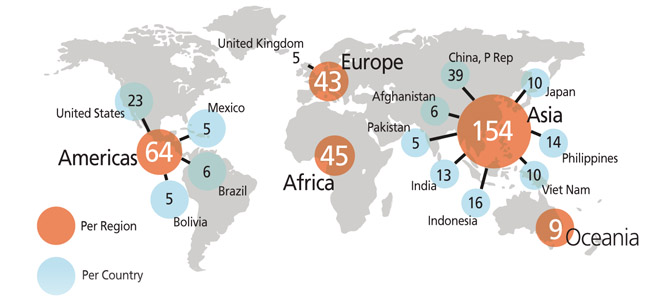J Korean Med Assoc.
2017 Feb;60(2):149-155. 10.5124/jkma.2017.60.2.149.
Disaster medicine: current status and future directions of emergency medical team for overseas disaster crisis
- Affiliations
-
- 1Department of Emergency Medicine, Yonsei University College of Medicine, Seoul, Korea. hsc104@yuhs.ac
- 2Center for Disaster Relief Training and Research, Severance Hospital, Seoul, Korea.
- KMID: 2368925
- DOI: http://doi.org/10.5124/jkma.2017.60.2.149
Abstract
- Through the Declaration of Montevideo in 2011, the World Medical Association suggested that doctors worldwide should be trained in basic disaster response regardless of their specialty. The Haiti earthquake in 2010, which had the highest number of foreign medical team dispatched from all over the world, proved that untrained and disorganized team only brought confusion. This event led the World Health Organization to develop the "˜Classification and Minimum Standards for Foreign Medical Teams in Sudden Onset Disasters ' in 2013. This guideline will become the standard for organizing an international emergency medical team. We should be able to provide high standard of care through field hospital set up and continuous training of disaster medicine specialists.
MeSH Terms
Figure
Reference
-
1. Centre for Research on the Epidemiology of Disasters. Annual disaster statistical review 2013: the numbers and trend [Internet]. Brussels: Centre for Research on the Epidemiology of Disasters;2014. cited 2016 Nov 29. Available from: http://cred.be/sites/default/files/ADSR_2013.pdf.2. Liu S, Chan TC, Chu YT, Wu JT, Geng X, Zhao N, Cheng W, Chen E, King CC. Comparative epidemiology of human infections with Middle East respiratory syndrome and severe acute respiratory syndrome coronaviruses among healthcare personnel. PLoS One. 2016; 11:e0149988.
Article3. Al-Tawfiq JA, Omrani AS, Memish ZA. Middle East respiratory syndrome coronavirus: current situation and travel-associated concerns. Front Med. 2016; 10:111–119.
Article4. Kim Y, Lee S, Chu C, Choe S, Hong S, Shin Y. The characteristics of Middle Eastern respiratory syndrome coronavirus transmission dynamics in South Korea. Osong Public Health Res Perspect. 2016; 7:49–55.
Article5. Center for Research on the Epidemiology of Disasters. 2013 Disasters in numbers [Internet]. Brussels: Centre for Research on the Epidemiology of Disasters;2014. cited 2016 Dec 27. Available from: http://www.cred.be/publications?field_publication_type_tid=18.6. Song HG, Kang BS, Song K, Jeong YK. Subacute-stage organized medical support services in a disaster area: analysis of medical support in the ’99 Taiwan earthquake. J Korean Soc Emerg Med. 2000; 11:362–371.7. Kim JW, Park SH, Jung YS, Cho JP. Analysis of medical service in the 1999 Turkey earthquake. J Korean Soc Emerg Med. 2001; 12:330–337.8. Kwak YH, Shin SD, Kim KS, Kwon WY, Suh GJ. Experience of a Korean disaster medical assistance team in Sri Lanka after the South Asia Tsunami. J Korean Med Sci. 2006; 21:143–150.
Article9. Ahn KJ, Kim YK, Park DY, Kim H, Cha KC, Lee KH, Hwang SO, Hyun DJ. Experience of a medical disaster assistance team during the subacute period after the Haiti earthquake. J Korean Soc Emerg Med. 2011; 22:200–205.10. Kim H, Ahn ME, Lee KH, Kim YC, Hong ES. Disaster medical assistance in super typhoon Haiyan: collaboration with the local medical team that resulted in great synergy. Ulus Travma Acil Cerrahi Derg. 2015; 21:143–148.11. Yoo TH, Jung WS, Sun KH, Park YJ, Kim SP, Kim SJ. Experience of a medical assistance for disaster caused by a typhoon of Haiyan in the Philippines. J Korean Soc Emerg Med. 2014; 25:223–230.12. Van Hoving DJ, Wallis LA, Docrat F, De Vries S. Haiti disaster tourism: a medical shame. Prehosp Disaster Med. 2010; 25:201–202.13. Jobe K. Disaster relief in post-earthquake Haiti: unintended consequences of humanitarian volunteerism. Travel Med Infect Dis. 2011; 9:1–5.
Article14. Miller AC, Arquilla B. Disasters, women's health, and conservative society: working in Pakistan with the Turkish Red Crescent following the South Asian Earthquake. Prehosp Disaster Med. 2007; 22:269–273.
Article15. de Ville de Goyet C. Health lessons learned from the recent earthquakes and Tsunami in Asia. Prehosp Disaster Med. 2007; 22:15–21.
Article16. Brolin K, Hawajri O, von Schreeb J. Foreign medical teams in the Philippines after typhoon Haiyan 2013: who were they, when did they arrive and what did they do? PLoS Curr. 2015; 7.17. World Medical Association. WMA Declaration of Montevideo on Disaster Preparedness and Medical Response [Internet]. Ferney-Voltaire: World Medical Association;2011. cited 2017 Feb 10. Available from: http://www.wma.net/en/30publications/10policies/d3/.18. Ishii M. Activities of the Japan medical association team in response to the great East Japan earthquake. Japan Med Assoc J. 2012; 55:362–367.19. Fuse A, Yokota H. An analysis of Japan Disaster Medical Assistance Team (J-DMAT) deployments in comparison with those of J-DMAT's counterpart in the United States (US-DMAT). J Nippon Med Sch. 2010; 77:318–324.
Article20. Nufer KE, Wilson-Ramirez G, Shah MB, Hughes CE, Crandall CS. Analysis of patients treated during four Disaster Medical Assistance Team deployments. J Emerg Med. 2006; 30:183–187.
Article21. Aitken P, Leggat PA, Robertson AG, Harley H, Speare R, Leclercq MG. Education and training of Australian disaster medical assistance team members: results of a national survey. Prehosp Disaster Med. 2011; 26:41–48.
Article22. Nagata T, Yoshida S, Hasegawa M, Ojino M, Murata S, Ishii M. International medical teams of the Japan Medical Association: a framework for foreign medical teams. Disaster Med Public Health Prep. 2016; 10:4–5.
Article23. Bookmiller KN. Professional standards and legal standard setting: INSARAG, FMTs, and international disaster relief volunteers. Vanderbilt J Transnatl Law. 2015; 48:957.24. Norton I, von Schreeb J, Aitken P, Herard P, Lajolo C. Classi-fication and minimum standards for foreign medical teams in sudden onset disasters [Internet]. Geneva: World Health Organization;2013. cited 2017 Feb 10. Available from: http://www.who.int/hac/global_health_cluster/fmt_guidelines_september2013.pdf.25. International Federation of Red Cross and Red Crescent Societies. Introduction to the guidelines for the domestic facilitation and regulation of international disaster relief and initial recovery assistance [Internet]. Geneva: International Federation of Red Cross and Red Crescent Societies;2011. cited 2016 Dec 13. Available from: http://www.ifrc.org/PageFiles/41203/1205600-IDRL%20Guidelines-EN-LR%20(2).pdf.26. Global Health Cluster. Health Cluster Guide [Internet]. Geneva: World Health Organization;2009. cited 2016 Dec 23. Available from: http://www.who.int/health-cluster/resources/publications/hc-guide/en/.


